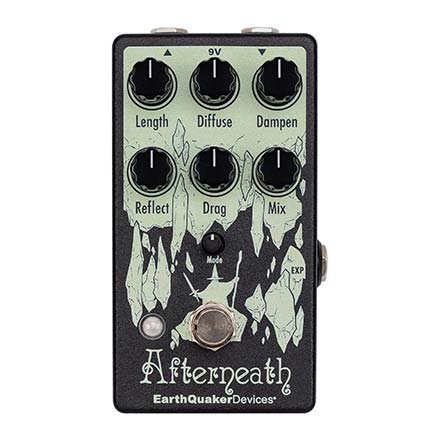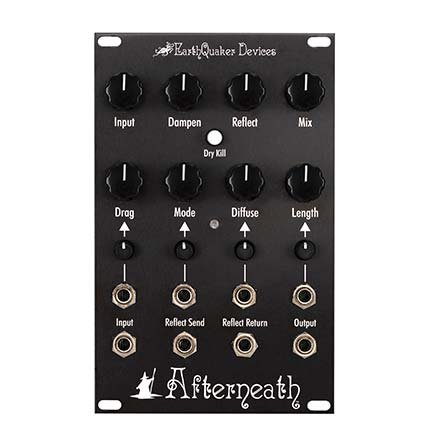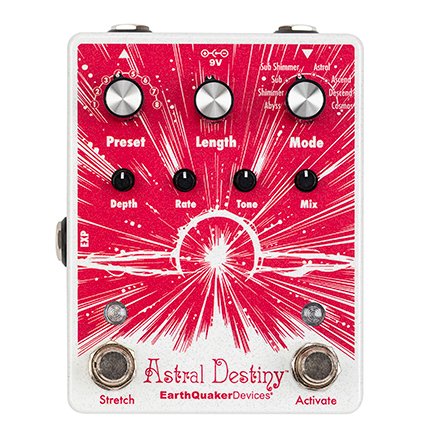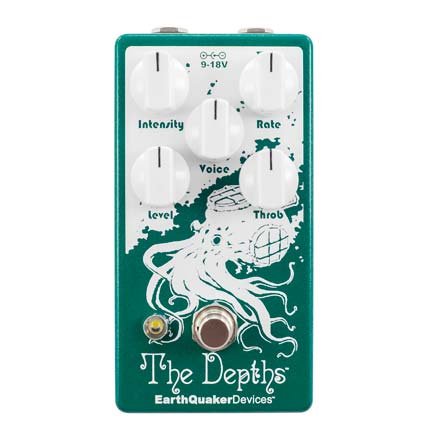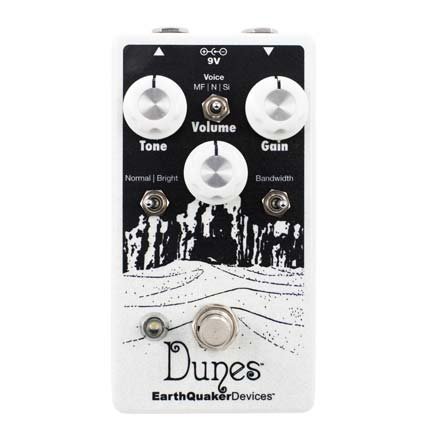EarthQuaker Symphony : A Confluence of Effects and Orchestra
Malcolm X Abram
For most music lovers, the concept of orchestral instruments and effects pedals makes strange bedfellows. The average symphony fan probably doesn't spend much time wondering what the opening notes to Beethoven's 5th Symphony would sound like with a bit of fuzz and flanger. And, the average pedal head may not wonder what ten violas sound like coming through an octave pedal.
But on March 5, the presumed disparate worlds of electronic effects and orchestral music will join forces for the world premiere of the EarthQuaker Symphony at E.J. Thomas Hall in downtown Akron.
The EarthQuaker Symphony has been in the works for several years, even before the pandemic pushed everyone's plans aside, according to Akron Symphony Orchestra conductor and music director Christopher Wilkins.
"We've sort of had our eye on doing something with EarthQuaker for a long time,” Wilkins said, noting the many connections between the two Akron staples. EarthQuaker CEO Julie Robbins is an ASO board member and first cellist Eri Rodriguez-Snowden's partner Samantha Wandtke is the "boxing and shipping Witch" at EQD. Her SamDoodles drawn in random pedal enclosures are highly coveted by EQD fans.
"It's an idea we've had running for a while. Using electronic effects in orchestras is nothing new. It's at least a century old, but I think the way in which we're doing it is unusual, to say the least, in that a number of orchestra players are playing through the effects pedals in addition to our soloists. And we have five or six different effects and five or six different orchestra players participating in addition to the two composers who are also on stage," Wilkins said.
The EarthQuaker Symphony program includes pieces by Haydn, Beethoven, and William Dawson, but the centerpiece is the world premiere of "Confluence" commissioned for the special evening. The piece features the orchestra plus soloists augmented by special guest performers and the co-composers of "Confluence," Jon Sonnenberg and Jake Gunnar Walsh. Sonnenberg is already a member of the extended EarthQuaker family, having helped lead designer and founder Jamie Stillman design and create the Afterneath Eurorack synth module and he is a veteran artist and composer who records as Travelogue. Walsh is an award-winning composer, much sought-after arranger, educator, and master oboist.
The piece also features a brand new instrument, the confluence harp, invented by Sonneberg, that Walsh will play during the performance. “Confluence” consists of six movements; five are named for the EarthQuaker Devices used.
I. The Depths
II. Afterneath
III. Dunes
IV. Aqueduct
V. Astral Destiny
VI. Terrae Motus (Latin for EarthQuaker).
The effects chosen by Sonnenberg are as follows: The Depths, an analog optical vibrato, the Afterneath, an "otherworldly" reverb, the Dunes, a TS-808 inspired overdrive, the Aqueduct, a vintage-inspired vibrato, and the Astral Destiny, a modulated octave reverb. Each section will feature soloists and orchestra sections augmented by the respective pedals.
Co-composers Sonnenberg and Walsh were brought to the project separately. It was Robbins who suggested Sonnenberg as the composer. Sonnenberg is a Northeast Ohio-based multi-instrumentalist, artist, composer, analog synthesizer wizard, and a gear and vinyl record accumulator.
When Robbins reached out, Sonnenberg was intrigued by the opportunity and the challenge and began communicating with Wilkins. "I really liked the whole idea of it. It was exciting. It's something that I've never worked with. I've worked with a lot of musicians, and I've worked with individual musicians doing a solo on a piece or something like that before," he said.
"I've recorded a lot of music. But most of my arrangements are on synthesizers and occasionally acoustic instruments, like a real drummer or something like that," Sonnenberg said.
Sonnenberg and Wilkins began discussing the possibilities, and Sonnenberg sent Walsh several of his electronic and synthesizer-based pieces, including pieces scored for video games and films.
"How does an orchestra become a part of it in a way that's not just an add-on, not just superficial? Where in there can I hear the richness that 85 musicians are going to bring to it?" Wilkins said.
After picking the pieces that would become the movements of "Confluence," Wilkins knew he needed more assistance to make the piece more than just versions of the tunes with strings.
"As I was listening to [the chosen pieces], I started to think of my past work with Jake and his ear for orchestral sound, color, texture, his familiarity with extended techniques, non-traditional ways of playing instruments. And I thought he would be a great person to do the orchestration, and then it turned out to be more than that," he said.
Wilkins then enlisted Walsh with whom he has previously worked to help arrange and expand the music for an orchestra. Walsh's first assignment was getting the music from the audio files onto the written page, a lengthy process interrupted by the pandemic.
"That was one of the biggest challenges, actually. Taking this thing that existed in this kind of free and more experimental sound world and having to strictly notate that for musicians who don't come from that tradition; orchestral musicians. Even the most brilliant musicians are still going to rely on a really coded set of musical notation. So that was the first step, and that was actually a long step," Walsh said.
Walsh and Sonnenberg began working on the pieces together, with Walsh suggesting the acoustic instruments he heard in his head in place of the synthesized and Midi-triggered originals.
"I would say, ‘I am hearing four stopped horns,’ and then I could bring that idea back to Jon, and we developed a sort of language, a shared language to be able to talk about these kinds of things, even though we come from different musical backgrounds. And then he could say, “I'm actually wondering if we can do something more like a trombone with a gliss or maybe muted trumpet," Walsh said.
As the pair of new collaborators worked, the pieces evolved into something new, with the pair co-composing more parts for orchestra sections such as percussion that weren't suggested by the initial recordings. Eventually, they realized they were co-composing. The melding of their different musical origins, styles, and backgrounds, plus the combination of effects and orchestral instruments together inspired the title "Confluence."
"In other words, it wasn't just Jake taking what Jon had done and making an orchestral version of it. They started to work together so that it's very hard to draw the line between who did what. But a lot of Jake's work ended up being original, and so we just had this really interesting partnership built around what the EarthQuaker Devices can do," Wilkins said.
Kimia Ghaderi tearing through some modern classics and some classic classics with Plumes and Avalanche Run.
EFFECTING AN ORCHESTRA
Turning synth and electronic-based music into an orchestral piece was one challenge. But there was another, picking and then using the effects ... effectively. The trio knew they didn't simply want to take the easy route and throw a reverb or delay on the viola section and call it "experimental."
"So luckily, the EarthQuaker component was always part of this project," Walsh said.
"There was never a time where Jon or I or Chris Wilkins were making any musical decisions that didn't have EarthQuaker Devices as a pretty high priority. So, for that, I'm really grateful because they made the effects really integral to the piece. We really wanted to avoid something that was just like, ‘Write a piece for orchestra and then throw on a Plumes pedal.' We thought it would read as cheesy or come across as disrespectful or something like that. So Jon and I really worked to make it so that the music served the pedal, and the pedals served the music. It was a lot more kind of connected in that way,” Walsh said.
Its origins may be in video game and film scores, but "Confluence" is a complicated piece of music. But Sonnenberg, a fan of non-traditionally structured experimental music, said he didn't want the piece to be confrontational or aggressively avant-garde.
"For me, it's always about melody and chords. No matter what I'm composing or what instruments I'm using. music should be a recognizable experience, and whether you're playing it on a guitar or playing in an orchestra, there still should be musical elements. In my definition, a song is something that can be covered on a different instrument and still be recognized as that song. So with that definition, I definitely always start with a melodic motif with some chords under it that I like,” Sonnenberg said.
The trio also wanted to ensure that the effects were more than just sonic frosting on an orchestral cake. "It's not like every instrument in the orchestra is going through a unique pedal. We handpicked about 13. So 13 different instruments will be going through the isolated mic and going through a pedal. Plus, the instrument that I created will be going through some reverb. So, there's some kind of vibrato, some random pitch shifts, some flanging, different reverbs, some filtering. A lot of delays and some distortions of different kinds," Sonnenberg said.
Wilkins, who won't hear the piece performed until rehearsals a few short days before the premiere but is studying the ever-evolving score, said the composing team has done a wonderful job of incorporating the effects as sound design.
"[Confluence] explores a lot of different elements of sound. So the color of the sound, the texture, meaning how the different elements interrelate rhythms, and the idea of counterpoint. Just how things fit together," Wilkins said. "For example, there's a moment where the orchestra just focuses on a single pitch, and that pitch is reverberated, and there's vibrato, and you hear it through the effects pedal, and then you hear a vibraphone do a very similar thing. And then you hear the pianist who has got his thumb on the string while he plays the key to alter the note. The goal will be to get those two to imitate each other, to sound like different versions of the same thing," Wilkins said.
THE PERFORMANCE
During the premiere of "Confluence,” Sonnenberg and Walsh will also be performing. Sonnenberg will be manipulating the pedals in real-time, and Walsh will be playing Sonnenberg's new instrument, the confluence harp. The new instrument combines aluminum chimes suspended on piano wire that are struck with various kinds of mallets.
Sonnenberg, a collector of world instruments, invented the confluence harp out of necessity. There's a section of the piece that Sonneberg said required "extra notes in this descending scale," so he invented the harp to get those microtonal sounds.
"This particular instrument is a confluence of strings and chimes in a way that's unique. So, the thing that's vibrating that makes the sound is a combination of strings and chimes. But it's not like the strings are separated from the chimes. The chimes are ringing the strings, and the strings are ringing the chimes,” Sonneberg said.
"And what's interesting about it is that the chimes are fixed frequency tuning, and the strings can be tuned to wherever. So you've got these really strange results whether or not the strings are tuned in unison with the chimes or as a harmonic or different things like that," he said.
Walsh has yet to actually play the confluence harp, but he's familiar with it and said he'll be ready for his big confluence harp solo during the Dunes movement of the piece.
SPECIAL MUSIC FOR A SPECIAL NIGHT
In addition to the world premiere of “Confluence,” Wilkins carefully chose the other pieces for the evening's program, desiring music that extends the traditional orchestral musical language and expressions.
Wilkins purposely put together an evening of dynamic music. Pieces such as Haydn's harmonically intense "Earthquake," Beethoven's percussion and rhythm-heavy pair of "The Ruins of Athens: Turkish March," and "The Creatures of Prometheus: Overture" and William Dawson's "Negro Folk Symphony” which brings together choral music, contemporary orchestral music, gospel, and West African drumming and rhythms.
"One of the things I love about the Akron Symphony right now is, we have a team that's really eager to push the boundaries and try new things. This is just a very cool instance of that," Wilkins said.
EARTHQUAKER SYMPHONY
Program:
Haydn "Earthquake" from The Seven Last Words of Christ
Beethoven The Creatures of Prometheus: Overture
Beethoven The Ruins of Athens: Turkish March
Sonnenberg/Walsh Confluence: Symphony for Orchestra & Effects
Dawson Negro Folk Symphony
Date:
March 5, 2022 at 8:00 pm
Venue:
E.J. Thomas Hall
198 Hill Street
Akron, OH 44325
Malcolm X Abram is a recovering reporter and music writer and a proud 40 year guitar noodler. He lives, works and plays in the bucolic dreamland of Akron, Ohio in an old house with two dogs who don’t really like each other and way too many spiders.


